Nepal, often remembered as the country of Mount Everest, the birthplace of Gautam Buddha, is much more than these wonders. Kathmandu Valley, alone houses 7 UNESCO World Heritage Sites. Out of these, Patan Durbar Square at the centre of the city of Patan is one of them. Patan, also known as Lalitpur, meaning "city of art”, was designated as the “World Craft City” in 2018 by the World Craft Council AISBL. The modern name Patan is derived from the Sanskrit “pattan”, which means “city”, whereas local Newari speakers call it Yala. At a distance of about 5 km from central Kathmandu, the city is best known for its rich cultural heritage, majorly its tradition of arts and crafts.
The Patan Durbar Square is home to various Hindu and Buddhist temples like Krishna Mandir and Buddha Temple, making it the centre of both Hinduism and Buddhism. Moreover, the historical centre Patan Museum with its three courtyards and lingering history is a must-visit. Out of the square, visitors can walk just a few minutes and encounter religious sites like the Golden Temple, Kumbeshwar Temple, Mahaboudha Temple, and others. The narrow alleys with local markets, artisan workshops, and delicious Newari dishes of the square keep one engaged throughout their visit. Patan Durbar Square offers a unique experience to anyone eager to discover Nepal's artistic and cultural heart, attracting travellers around the globe.
Also Read: Kathmandu Durbar Square
Patan Durbar Square Facts
Here are some facts related to Patan Durbar Square:
|
Site Name |
Patan Durbar Square Yela Layeku (Newari name) |
|
Location |
Patan, Lalitpur |
|
Architectural Style |
Newari architecture |
|
Nearby Attractions |
|
|
UNESCO Listed |
1979 AD |
|
Festivals |
|
|
Entry Fees |
|
|
Opening and Closing Time (Patan Museum) |
Note: Every Wednesday Sundari Chowk Galleries Closed. Every Tuesday, Sundari Chowk Galleries is closed at 2.30 PM for regular maintenance. |
Patan Durbar Square History
The fact that Patan is one of the oldest inhabited areas of the Kathmandu Valley cannot be denied, tracing its roots back to the 3rd century B.C. David Llewellyn Snellgrove, a British Tibetologist famous for his pioneering work on Buddhism in Tibet, suggested Patan to have originated before the beginning of the Christian era as a Buddhist community. The Patan, also known as “Lalitpur”, is known by various names such as Yal, Lalitapuri, Maningal, and others. According to an old Kirat chronicle, Patan was founded by the Kirat rulers and they made it their capital long before the Licchavis were seen in the political environment of the Kathmandu Valley; hence the name "Yal" came after the name of the first Kirat king, Yalambar.
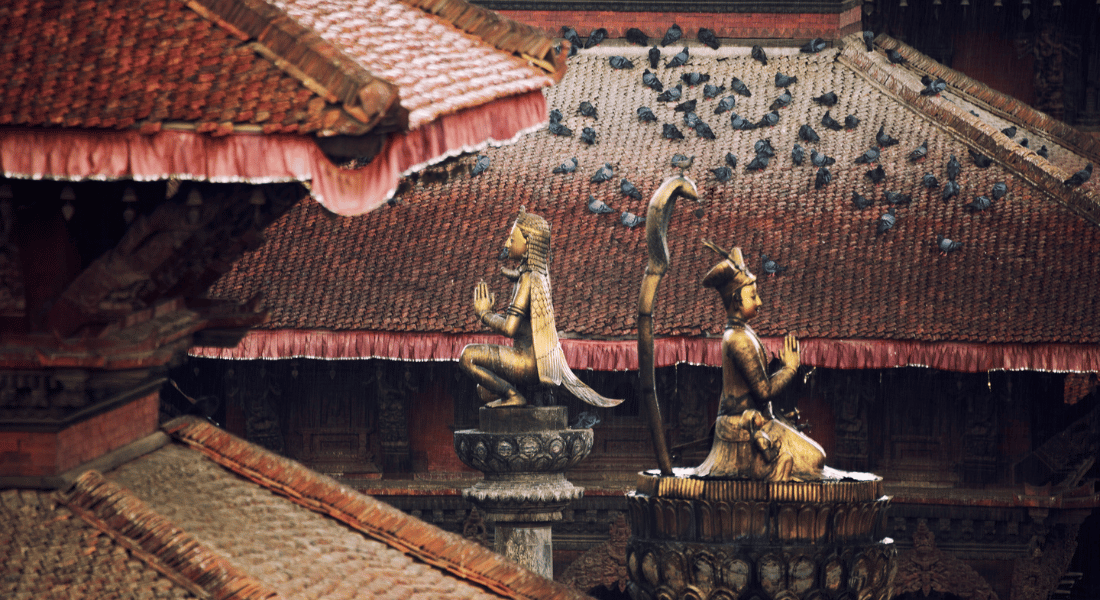
Once the Lichhavis came into power, the city was expanded, and the area was known as Yupagram. Newar Buddhists claim that 4 Thurs (big Chaityas) were built in the outer area of Patan in a swastika shape by Emperor Ashok (250 B.C.) of Magadh, India, during his visit to the Kathmandu valley with Lord Buddha (6th century B.C.). With 24 Lichhavi inscriptions, statues, and stone streams being found here, these archaeological sources indicate that the city was fully developed in this period. Later it became the major centre for art and architecture and developed to the present state during the Malla period.
Contribution of Malla Kings
Patan was said to have been ruled by six Pradhan brothers, intelligent and sharp with abundant wealth and power to change the kings on a whim. With their influence, about 6 Malla kings were changed over 25 years of their prime time. While the history of Patan Durbar is often seen to be associated with these Pradhanas and the Thakuri dynasty, who are believed to have made changes, the Malla Kings are the ones who held the privilege to make the square complex to what it stands today.
For more than five centuries, the historic Patan was ruled over by the Mallas (12-17 centuries), making major changes to the square. The palace complex, which was called “Chaukot” in ancient times, is believed to be the creation of three kings: Siddhi Narsingh (1619-1667), his son Shrinivas (1660-1684) and his son Yognarendra Malla (1684-1705). The palace was renovated once by King Srinivas Malla in 1674 AD and then by King Vishnu Malla in 1734 AD. In the late Malla period, Kantipur (Kathmandu), Kirtipur, Lalitpur, and Bhaktapur were the four secure cities of Kathmandu Valley. These cities competed with each other to make their own kingdom attractive. So, the kings enriched their cities with the construction of new monuments and temples. The notable structures in the vicinity of the square built during this period include Krishna Mandir (1667 AD), Bhimsen Temple (1680 AD), Taleju Bhawani Temple (1640 AD) and Vishwanath Temple (1627 AD). With the greatest achievements in art, architecture, and culture in their era, the Malla period was known as the golden period of Nepalese art.
In 1979 AD, Patan Durbar Square, along with two other squares in the Kathmandu Valley, was declared a UNESCO World Heritage Site of Kathmandu. And, since 1997 AD, the mediaeval Patan royal palace has been transformed into the Patan Museum. Over the years, the square has gone through various challenges, like the deadly earthquake of 2015. However, with the restoration and the living spirit of the local people, the square is still intact and alive to date, carrying thousands of legends and histories within its walls.
Also Read: Bhaktapur Durbar Square
Architectural Background
The art and architecture of the Kathmandu Valley are deeply associated with the Newars, who are known for their artistic skills. Back in the days, when there was competition among the kingdoms of the Kathmandu Valley to beautify the city, it was not only the kings involved in it. It also existed between the Newari craftsmen between the cities. This resulted in houses, buildings, dharamshalas, monasteries, palaces, and temples in the vicinity of the Durbar Square being built in a Newari architecture.
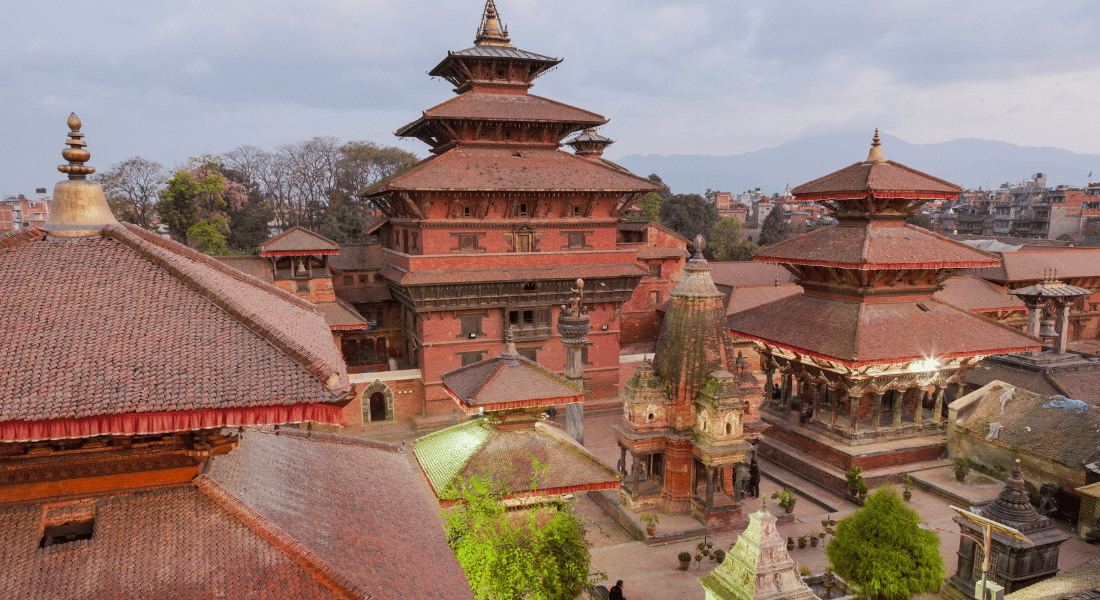
The Patan Durbar Square complex involves the palace, temples, monasteries, houses, and dharamshalas, which are exceptionally fascinating art of the Malla period. Every individual element of a building, such as windows, doors, walls, pillars, and beams, is richly and detailed carved in each structure. Moreover, special kinds of brick, wood, roof tiles, and clay were used in these buildings, making them unique in an artistic and architectural way. Also, as a roof covering, metals (usually copper) can be found in more elaborate structures. The materials used in all these treasures are also one of the reasons that make this square different from any other structures in the world.
Some of the architectural masterpieces of the Patan Durbar Square are Patan Museum, Krishna Mandir, Kumbeshwar Temple, Golden Temple, Rato Machindranath Temple, Mahaboudha, and others. These temples, mostly in pagoda style and some in Shikhara style, display the richest and most distinguished expression of Nepalese art compared to the other two Durbar Squares.
List of the structures within the Patan Durbar Square:
|
Structures |
Architectural Style |
|
Patan Museum |
Mix of European Style and Nepalese Style |
|
Krishna Mandir |
Shikhara Style |
|
Golden Temple |
Pagoda Style |
|
Kumbeshwar Temple |
Five Stories-Pagoda Style |
|
Rato Machhindranath Temple |
Newar Style Pagoda |
|
Mahaboudha Temple |
Shikhara Style |
Patan Durbar Square Significance
Patan Durbar Square, dating back to its history in the 12th century, showcases exceptional Nepalese architecture, royal history, and the artistic achievements of the Malla period. It is one of the most important landmarks of Nepal, holding profound cultural and religious significance.
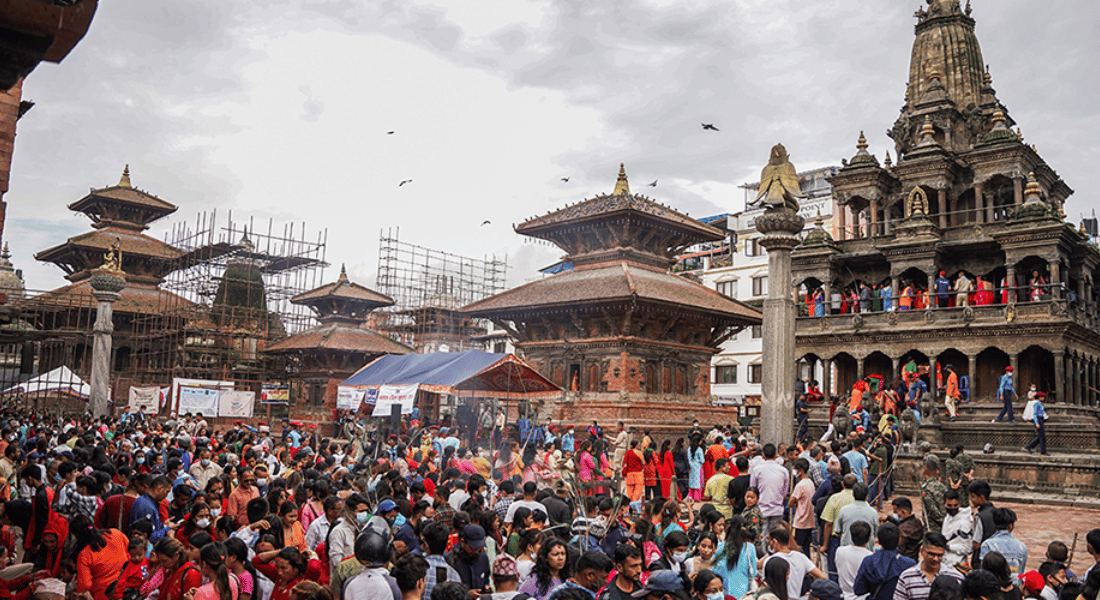
Religious Significance
Besides being a historically significant site, Patan Durbar Square holds immense religious significance for both Hindus and Buddhists. The square houses many temples, stupas, and shrines in its region, making it the major point for religious activities. For example, Krishna Mandir, one of the most revered Hindu temples in Patan, is dedicated to Lord Krishna and is a key site for devotees, especially during festivals like Krishna Janmastami, which celebrates the birth of Lord Krishna. Apart from the Hindu temples, it is also home to important Buddhist sites like the Golden Temple and Mahaboudha. These temples and shrines together are considered to portray the perfect blend of Hinduism and Buddhism. Also, religious festivals like Krishna Janmastami, Rato Machindranath Jatra, Gunla Parva, and others also play a key role in enhancing the religious significance of the site.
Cultural Significance
Patan Durbar Square, housing various temples, courtyards, and palaces, dates back to the Malla period, which serves as a royal palace complex for the Malla Kings. So, the local life revolves around these sites. The Newar people, being the major inhabitants of the area, Patan Durbar Square is deeply intertwined with their tradition, festivals, arts, and artisans. The cultural tradition of the Newars is blended perfectly with the urban society, boasting their unique craftsmanship of wood, brick, stone, and other materials in the world. Also, various festivals, events, and ceremonies keep the city alive, attracting both locals and tourists here.
As a UNESCO World Heritage Site
What is the value of being listed as a UNESCO World Heritage site? Patan Durbar Square, as one of the 7 UNESCO World Heritage Sites of the Kathmandu Valley, was listed in 1979 AD due to its rich historical and cultural significance. Various ancient heritages found in this vicinity date back to the 6th century, adding to its historical significance. Gaining this prestige has assisted the citizens and governments in the conservation of these heritages in and around Patan to date.
Major attractions of Patan Durbar Square
Patan is a center of Hinduism and Buddhism with 136 courtyards/Bahals and 55 major temples, most of these being in the surrounding area of Patan Durbar Square. The square boasts numerous beautiful and artistically fascinating structures, attracting both the locals and tourists. Most of the building dates back to the Malla period, with some stone scriptures dating back to the Lichhavi period as well. Here are some major attractions in and around Patan Durbar Square:
Patan Museum
Patan Museum, previously a royal palace, was transformed into a museum in 1997 AD. The exhibits cover a long span of Nepal’s cultural history and explain the meaning and context of Nepal’s living tradition of art. The museum with three courtyards, Taleju Temple, Degu Taleju Temple, and Bhandarkhal Tank, was once the residence of the Malla Kings. It has an impressive collection of ancient sculptures, artifacts, metal scriptures, and artworks that highlight the rich heritage of the city. Moreover, it also includes a cafe, a guest studio for artists, gift shops, and an open courtyard space that hosts cultural events.
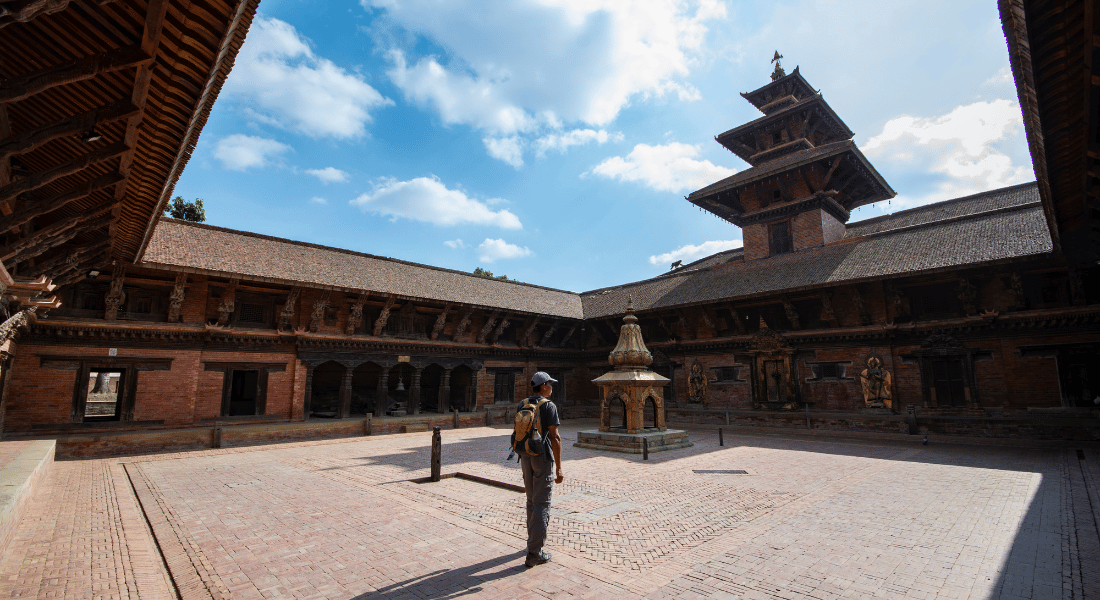
|
Attractions in Patan Museum |
|
Golden Doorway |
|
Three Courtyards; Keshav narayan Chowk, Mul Chowk and Sundari Chowk |
|
Yantaju Shrine |
|
Bhandarkhal Tank |
|
Tusha Hiti step-well |
|
Architecture Galleries |
-
Keshav Narayan Chowk: A temple is located at the centre of the courtyard known as Keshav Narayan, dedicated to Lord Vishnu. The courtyard is named after it. It is renowned for its four-tower pavilion reflecting the fusion of Hindu and Buddhist architectural styles.
-
Mul Chowk: Mul Chowk, the central courtyard of the palace, is the heart of the Patan Durbar, which is the largest courtyard of the palace. It was established by Srinivasa Malla and later renovated in 1730 and 1850. Vidya Temple is located at its centre and Taleju temples are easily seen from the courtyard.
-
Sundari Chowk: This courtyard is at the southern side of the Durbar, which was originally constructed as a two-storied building where an additional story was added after renovation in 1730. It includes a step well called Tusha Hiti, an oval-shaped well accompanied by a spout with an image of Laxmi Narayan on Garuda.
Krishna Mandir
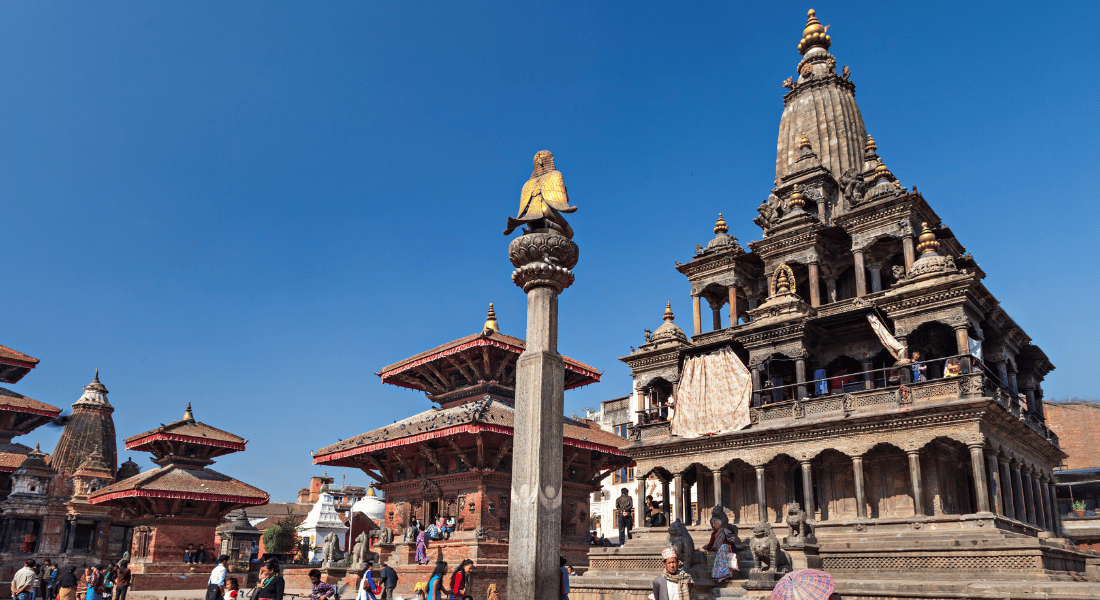
Krishna Mandir is a temple built by King Siddha Narshinga Malla in the 17th century. The whole temple is made up of stone with three floors, has around 21 Gajurs and its beams are carved with the images based on the story of the Mahabharata. It is said the spot where the temple is built was a location reserved to build a Mahadev temple. When the ground was dug, a Krishna idol was found. So, the Krishna temple is built below, which is on the middle floor and the Shiva temple is placed above. Also, there are ten incarnated idols of Vishnu around the idol of Krishna. This particular temple attracts a large number of devotees on the occasion of Krishna Janmashtami, where prayers, flowers, incense, and tikas are offered to Shree Krishna.
Golden Temple
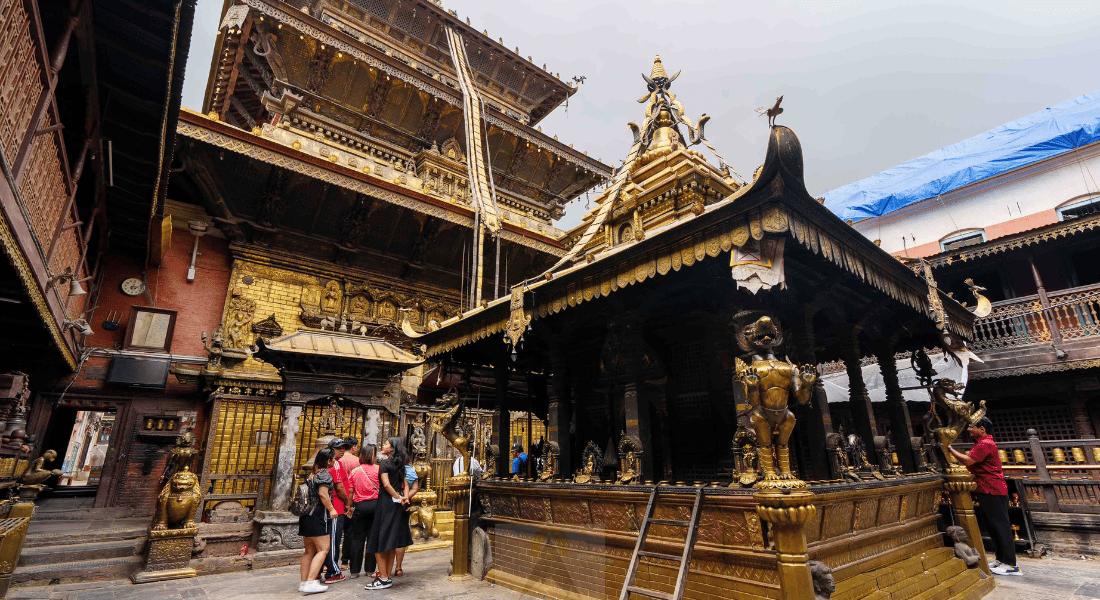
Locally known as ”Kwa Baha”, Golden Temple is a Buddhist monastery dedicated to Shakyamuni Buddha. It was built in the 12th century by king Bhaskar Varma and the whole structure is gold-plated, with the donations said to have been provided by the local merchants who did trading with Tibet. The whole complex is in the Nepalese Bahal style with the main entrance, a rectangular almost square courtyard and another entrance to the main temple. This two-storied pagoda temple has a golden image and a large prayer wheel in the upper story. Moreover, this sacred temple stores an 800-year-old Buddhist text, Pragya Paramita, which is one of the four places in Nepal where this text is found and is restored every three years.
Mahaboudha Temple
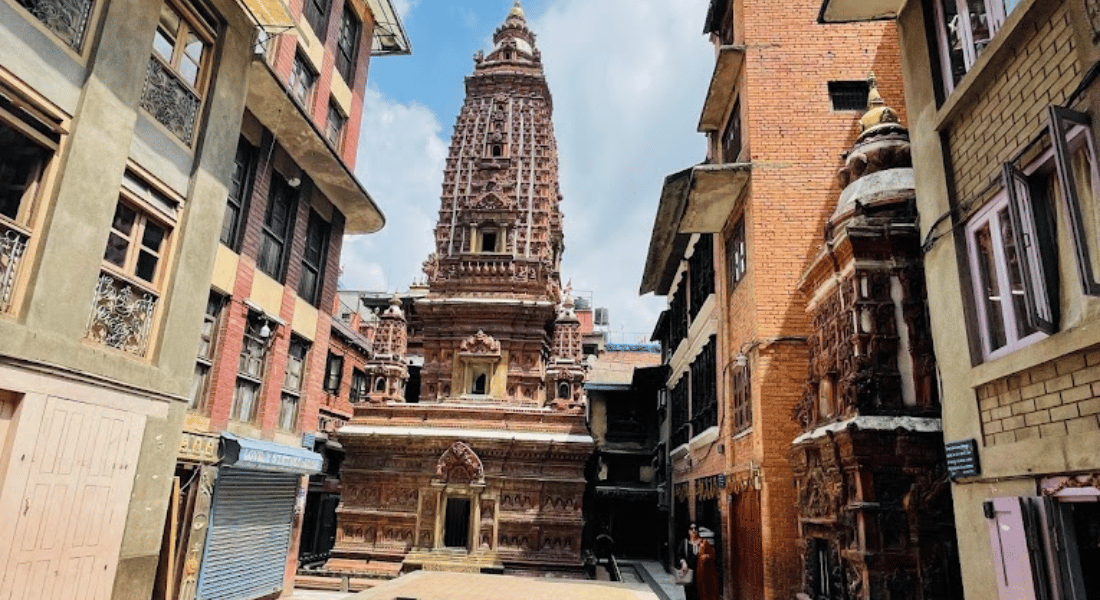
The Mahaboudha Temple, dating back to 1585, is also called the Temple of Thousand Buddhas, as a Buddha image is carved in every brick, which took around 36 years to construct. This Shikhara-style temple is the inspiration for the Mahabodhi Temple of Bodh Gaya. On the outer face of the temple, there are around 9000 Buddha idols, out of which 3400 are Buddha portraits and others are the symbols relating to it. The temple is decorated with various statues of gods and goddesses, like Buddha statues, Dhritarashtra, Birupakshya, Bodhisattvas, Kuber, and Birudhak, along with carvings of asthamangal (Eight Auspicious signs), Padmawali, Jwalabali, and Bajrabali.
Pimbahal
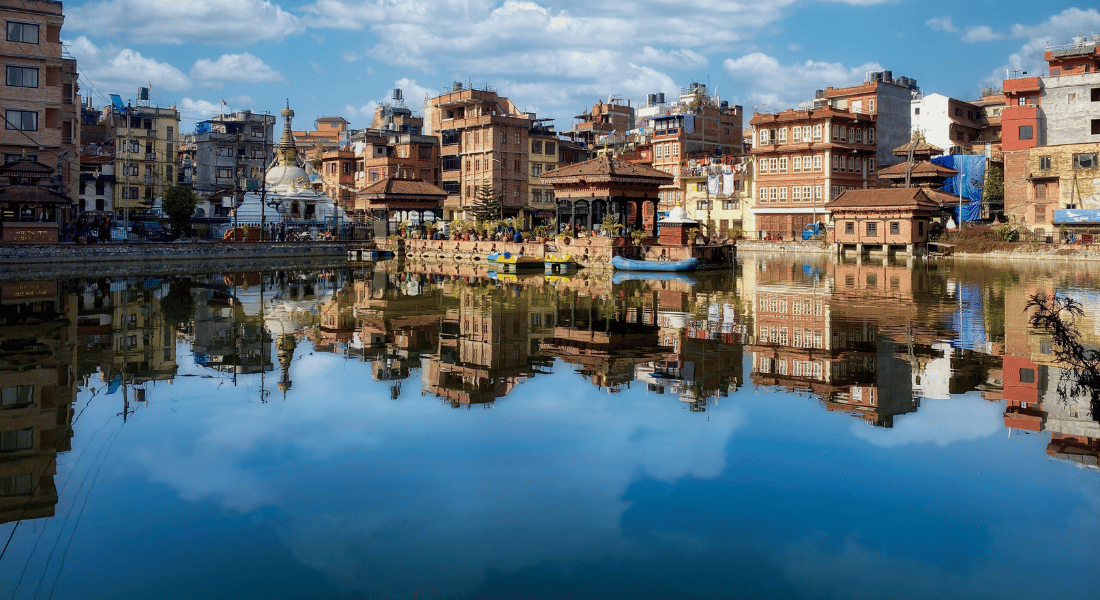
Pimbahal, also known as Jagamadu Pukhu, is an artificial pond located near the Patan Durbar Square, said to have been built without the use of any mortar or clay by piling up stones only. It is said that the pond was built by Lakhey (Demi-god). Among many legends, one says that during the wintertime the taps would run dry and the Lakhey’s wife had to travel far to get water. So, the Lakhey built a pond in one night to please his wife. The locals have a belief that if the pond gets dry and the stone lying in the northeastern corner of the pond is exposed to the sun, it will rain soon. At present, the area of Pimbahal is bustling with cafes, restaurants, and local crowds.
Kumbheshwar Temple
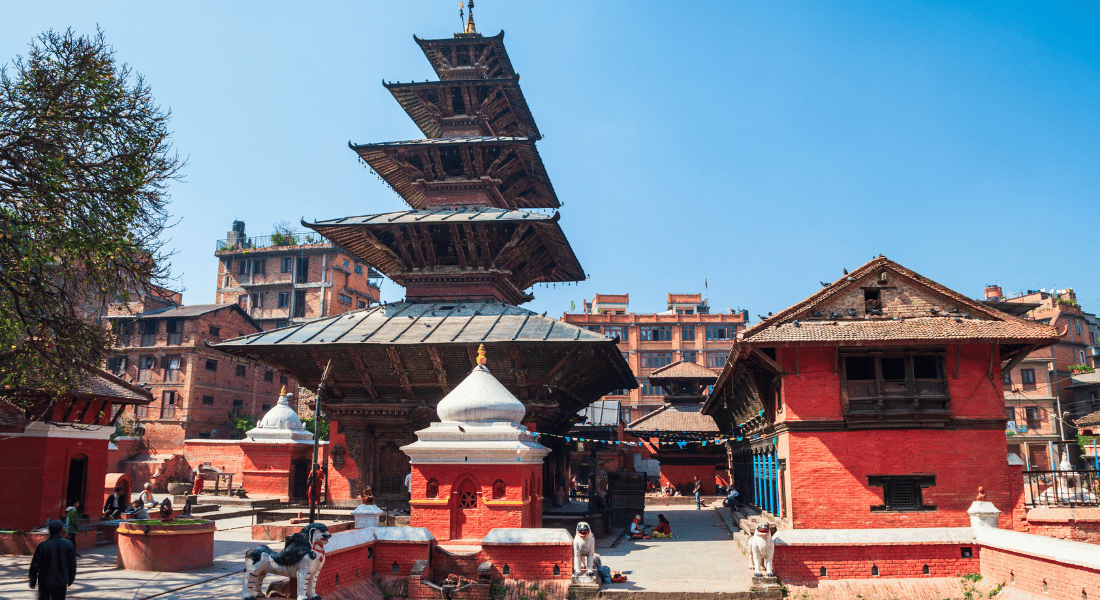
Kumbheshwar Temple, a five-storied pagoda temple, was built in 1392 during the reign of King Jayasthiti Malla, making it the oldest temple in Patan. The main temple is dedicated to Lord Shiva, appreciated for its fine woodcarvings. The temple complex includes the Bangalmukhi Temple, Ulmanata Bhairava, and two hiti ponds. The temple draws a large number of crowds in the festival of Janai Purnima, as it is believed that the water in the pond is from the holy lake Gosaikunda and taking a dip here is the same as taking a dip in Gosaikunda.
Baglamukhi Temple
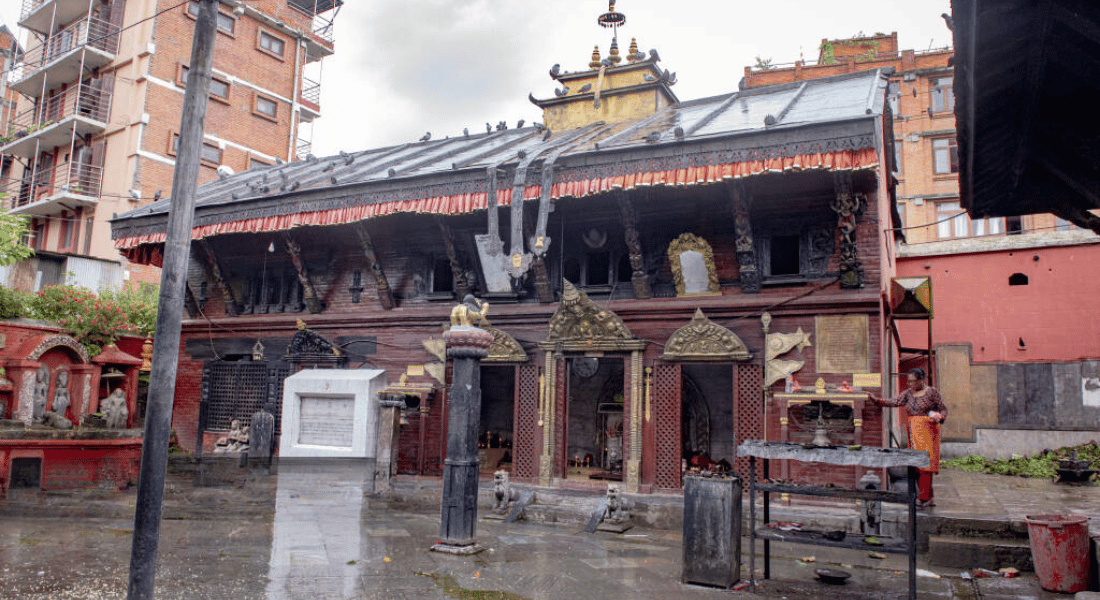
Baglamukhi in the same complex of the Kumbeshwar Temple and to its north is of great significance for the Hindu pilgrims. Considered as one of the important Shakti Peeth of Lalitpur, this temple is also called Pitambari, which means Lord Vishnu. It is said that once a powerful force came to destroy the entire universe and Lord Vishnu worshipped a lake called Haridra in the Saurashtra country on Tuesday's Chaturdashi Tithi; as a result, Bangalmukhi Mata was born at midnight. The temple is especially crowded on Thursday to gain the optimism of Jupiter, as the Goddess is considered the Lord of Jupiter.
Festivals in Patan Durbar Square
As it is said, Nepal celebrates more festivals than days in a year. Every day there is something going on, making festivals part of daily ways of life. Festivals are much more than celebrations; they are the form of culture, storytelling, traditions transferred from generation to generation, and histories connected with it. Patan, as one of the major cultural centres for the Newar community, hosts various festivals throughout the year, which include Rato Machindranath Jatra, Gai Jatra, Mataya Jatra, Gunla Parva, and many more.
Rato Machindranath Jatra
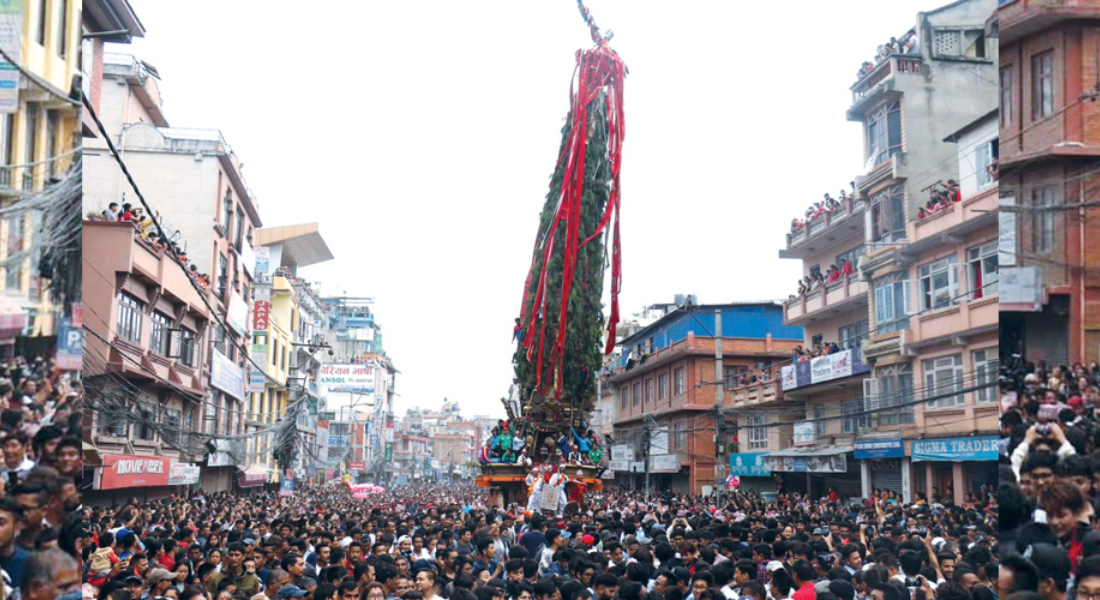
The festival, Rato Machindranath Jatra, which falls in May of every year, is the longest chariot festival in Nepal. According to legend, around the 6th century, Nepal went through a devastating drought for about 12 years. Rato Machindranath (Bunga Dyah) is a deity brought from India to Lalitpur, hoping to put an end to it. Hence, the festival was initiated during the reign of King Naradev to welcome the rain. Every year, the festival begins with the construction of a 60-foot-tall chariot in Pulchowk. The chariot is pulled all the way from Pulchowk to Gabahal, Mangal Bazar, Hakha, Sundhara, Chakrabahil, Lagankhel, and finally at Jawalakhel. The parade concludes with the ceremony of Bhoto Jatra, which is displaying Bhoto, a traditional Nepalese vest.
Gai Jatra
Gai Jatra (Sa Paru), also known as the cow festival, is a traditional Newari festival that falls in late August, in the Bhadra month of the Nepali calendar. This is celebrated to honour the close ones who have died the previous year. It was started during the reign of King Pratap Malla to share the sorrow of his wife for their son’s death. During this festival, people, mostly children, dress up as cows to parade on the streets.
Another fun fact about this Jatra is that, back in the days during the monarchy system, only on this day the Kings allowed the people to criticize them sarcastically in public on a stage where Kings were invited as the special guest. Likewise, the same custom is followed to this date, where on this day politicians are invited to the Gaijatra program and criticised in public.
Learn More: Gai Jatra Festival in Nepal
Mataya Jatra
Mattaya festival, also known as the festival of light, is celebrated in Patan, especially by the Buddhist Newars of Patan. This festival that comes right after the celebration of another festival, Gai Jatra, falls around Autumn-September. It is the major part of the celebration of the holy month for Buddhist Newar “Gunla”. In this festival, those who have lost their family members or relatives participate and make a round to the four stupas located in the four different ends of Patan. The main highlight of the festival is people making a parade with various musician groups playing flutes, Dhime Baja, carrying lighted candles while wearing traditional attires.
Gunla Parva
Gunla Parva, celebrated for a whole month and considered a holy month by Buddhists, falls on the August month of the Gregorian calendar. In these months, the devotees recite scriptures, observe fasts, and make a parade to various Buddhist structures playing Gunla Bajan (music). The major days of this celebration are Panjaran, Buddha Display, Bwo-gi, and Mataya.
A myth states that, once during the Malla time, there was a small river flowing along the palace front of Patan, which is believed to exist even today underground as a sewer drain. On its bank, a Buddhist monastery was built where an auspicious light is said to have emerged from the water. However, to increase the palace space, the monastery was later transferred. So, every year during the month of Gunla, a Buddha image is placed in the sacred water of a vessel placed right in front of the museum gate.
Also Read: Nepal Festival Calendar
Opening Time and Entry fees
The Square is open to the public 24/7 but the counter remains open from 7AM to 6PM. It is open throughout the year except for some particular special occasions. However, the galleries of the museum are closed for half of the time on some days for maintenance purposes. Moreover, the opening and closing time of the museum also depends on the season of the year.
|
Patan Museum Opening Time |
|
|
Summer (February 31st to November 1st) |
Galleries: 08:00 AM to 06:30 PM Keshav Naryan Chowk, Mul Chowk, Sundari Chowk: 07:00 AM to 06:30 PM |
|
Winter (November 2nd to January 30th) |
Galleries: 08:00 AM to 05:30 PM Keshav Naryan Chowk, Mul Chowk, Sundari Chowk: 07:00 AM to 05:30 PM |
|
Note: Every Wednesday, Sundari Chowk Galleries are closed. Every Tuesday, Sundari Chowk Galleries are closed at 2.30 PM for regular maintenance. |
|
For the entry fees of the square, it differs according to your nationality. One can get their entry ticket to the square from ticket counters located in different entry points of the square, whereas for museum, the entry ticket can be purchased from the entry point of the museum.
|
Entry Fee |
|
|
Foreign Nationals |
NRP 1000 (including museum) |
|
SAARC National |
NRP 250 (including museum) |
|
Nepalese |
NPR 30 (museum only) With Student ID NPR 15 (museum only) |
How to get there?
Patan Durbar Square is just some kilometres away from Kathmandu city. If you are staying in Patan, it is just a few minutes of walking to the Durbar Square. If you’re in Kathmandu, you can easily reach there by: taxi or public vehicle.
Taxi: It is a convenient option to transfer from Kathmandu to Patan, which takes you not more than 20 minutes. You can find it from anywhere in the city.
Public vehicle: The local buses/microbuses regularly run from Ratnapark, Kathmandu, to Pulchowk, Lalitpur, which might take around 30-45 minutes depending upon the traffic. You will need to reach a particular location to catch the bus and also need to walk to the Durbar Square once you reach Pulchowk.
Things to Do
When you are in Patan Durbar Square, there’s no way you’ll get bored. You will not notice when the time goes by, as there’s something to explore and see for anyone. Here are some of the many things you can do while you’re in Patan.
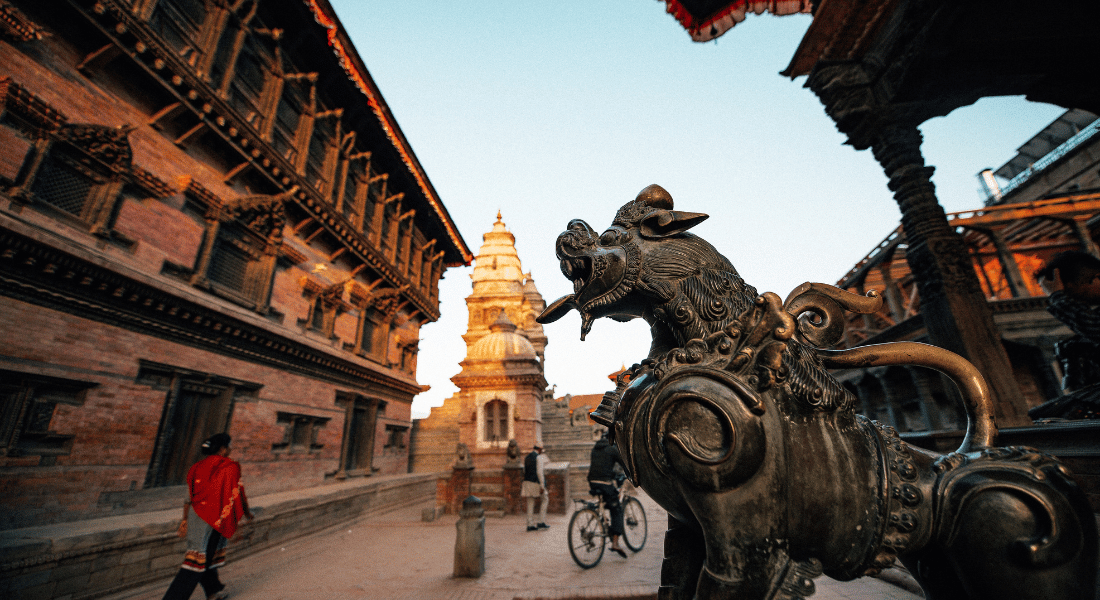
Stroll around the square
Visiting Patan Durbar Square feels like being taken to ancient times but with modern twist, as the urban settlement mingling perfectly with ancient heritage. The square comprises temples, shrines, stupas, and palaces, none of which you should miss exploring. The buildings epitomize rich Newari craftsmanship, each having its own legends and stories.
Try Pottery
Near the square, you can find the potter studio to involve yourself in the potter activity. From the beginning to the end, you can create your own kind of items, such as cups, bowls, or your own kind of creation. This firsthand experience lets you connect deeply with your own craft and leave with a personalised souvenir.
Explore the local market
The area around Patan Durbar Square is filled with the vibrant local markets where you can find locals selling handicrafts, clothes, jewellery, and other religious items. The narrow alleys, dark yet colorful, are lined up with stalls, shops, and crowds of the locals. If you want a souvenir to take, exploring the local market will be the best idea for you.
Try authentic local (Newari) foods
Patan is one of the many places where you can try the authentic Newari cuisines. You can find restaurants large to small. However, if you want to have authentic ones, the small local places are the best choice. The most popular Newari dishes include Samay Baji (a traditional Newari platter with beaten rice, bamboo shoot soup, and various accompaniments), Chatamari (a type of rice crepe), and Yomari (a sweet steamed dumpling-type dish). The food is often paired with traditional drinks like Chhaang (fermented rice drink) or Raksi (a strong local alcohol).
Practical Tips for Visitors
Patan Durbar Square is a must-visit destination for anyone visiting Nepal. There’s so much to do and so. To get the most out of it, it's important to have some knowledge beforehand regarding the suitable time to visit, local customs, and other practical tips. With some knowledge and a little preparation beforehand, you will get to experience the best of Patan Durbar Square. Here are some practical tips to make your visit to Patan Durbar Square easier:
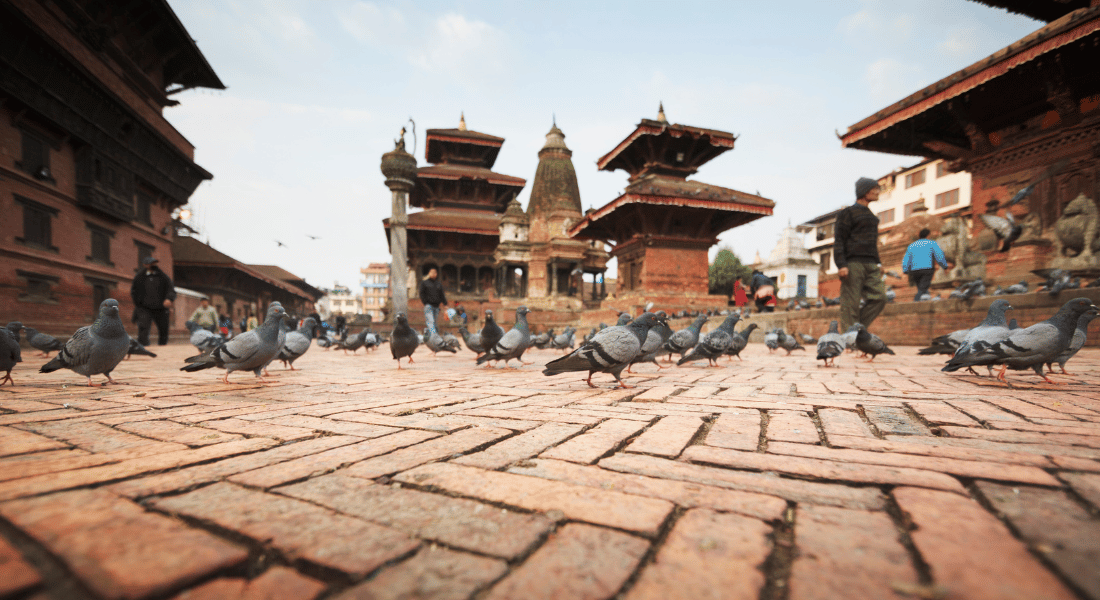
Best time to visit
Timing your visit to Patan Durbar Square is very important, as Patan Durbar Square is a cultural hub and it can be very crowded, mostly during the festive time or weekends.
If you want to experience the festivals of the square, you can schedule your visits during those seasons. Moreover, for the best time of the day, to avoid the larger crowds and get the best of Patan, you can schedule your visits in the morning or late afternoon.
Hiring a guide
Patan is overflowing with its history and culture. You might want to learn deeply about each structure. Considering this, you can hire a knowledgeable guide, which is a great way to enhance your experience. Hiring a local guide familiar with the area who can provide deep insights into the culture, traditions, arts, and artifacts is the best idea.
Dress Modestly
As Patan is a religious and cultural centre, it's important to dress respectfully, mostly in areas such as temples and shrines. There is no strict dress code; however, dressing modestly, such as wearing clothes that cover the shoulders and knees, is recommended.
Photography and Videography Tips
There are plenty of opportunities to document the culturally and architecturally rich city of Patan. However, there are also places strictly not allowed to take photos and videos. Be mindful of the action where it is not allowed. Moreover, there also might be people who don't want to get photographed. So, you need to be mindful when documenting the people and it's better to ask for permission before doing so.
Conclusion
Patan Durbar Square, as one of the UNESCO World Heritage Sites of Nepal since 1979 AD, is a must-visit site for anyone visiting Nepal. With its extraordinary culture, art, and history, it draws visitors from around the world to admire its architectural grandeur and explore the fusion of both Hindu and Buddhist influences in it that have shaped it over centuries.
Despite facing various challenges, including the devastating earthquakes of 1934 and 2015 that wreaked havoc, the square has been restored piece by piece. While cities often struggle to make a balance between a modern way of life and historical value. For the ancient preserves like Patan Durbar Square, it has found its way to fit the perfect coordination between modernization and the unique ancient settlements.

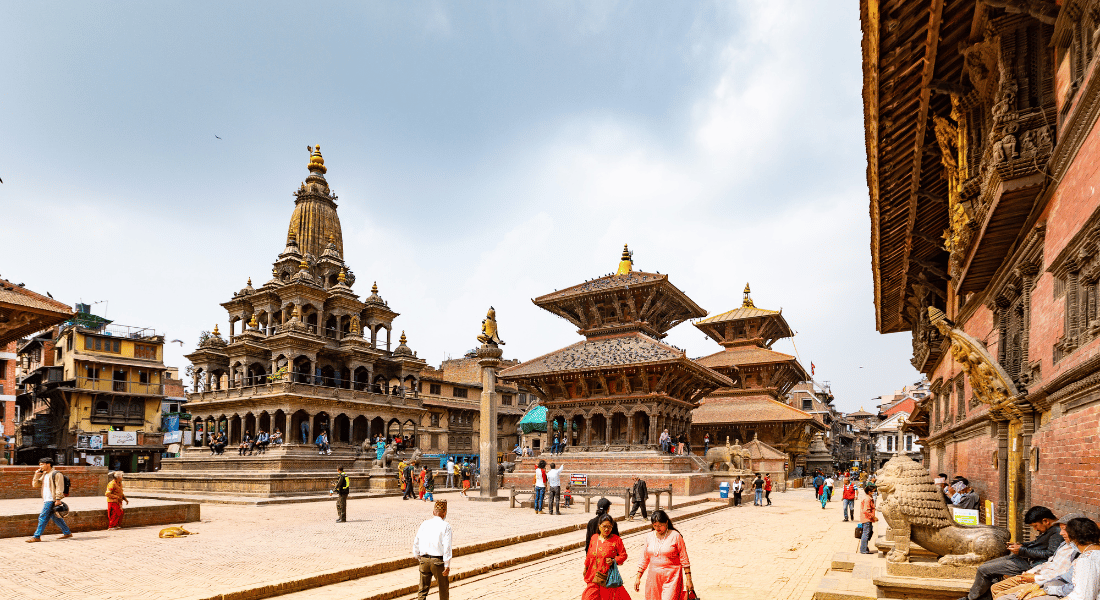
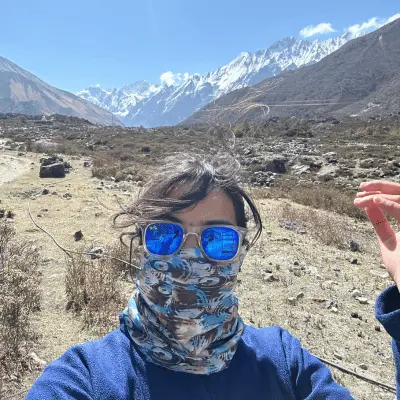 Mandira Itani
Mandira Itani